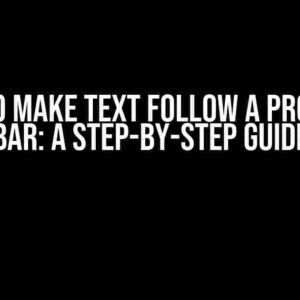If you’re a developer or a website administrator, you’ve probably stumbled upon the complex world of URL rewriting. It’s a crucial aspect of Search Engine Optimization (SEO) and website maintenance, yet it can be daunting for many. In this article, we’ll demystify URL rewriting and provide a step-by-step guide on how to remove encoding and use rewrite annotations. Buckle up, folks!
Understanding URL Rewriting
URL rewriting is the process of altering a website’s URL structure to make it more search engine friendly, user-friendly, and easier to maintain. It involves modifying the URL to remove unwanted characters, make it shorter, and more descriptive. This technique is used to:
- Improve website ranking on search engines
- Enhance user experience by providing cleaner and more readable URLs
- Reduce website maintenance by minimizing URL variations
- Improve website security by removing sensitive information from URLs
The Importance of Removing Encoding
URL encoding is the process of replacing special characters in a URL with a percentage sign (%) followed by a hexadecimal value. While encoding is necessary for URLs to work correctly, it can lead to:
- Ugly and lengthy URLs that negatively impact user experience
- Search engines indexing multiple versions of the same URL, leading to duplicate content issues
- Deterioration of website performance due to increased URL complexity
Removing encoding is crucial to ensure clean, readable, and SEO-friendly URLs. But before we dive into the process, let’s cover the basics of rewrite annotations.
Introduction to Rewrite Annotations
Rewrite annotations are instructions used to modify URLs. They consist of a set of rules that tell the web server how to rewrite URLs. There are two types of rewrite annotations:
- mod_rewrite rules: These rules are used to rewrite URLs at the Apache web server level.
- Rewrite annotations in configuration files: These annotations are used to rewrite URLs at the application level, typically in configuration files like .htaccess or web.config.
In this article, we’ll focus on using mod_rewrite rules to remove encoding and implement URL rewriting.
How to Remove Encoding and Use Rewrite Annotations
Now that we’ve covered the basics, let’s dive into the step-by-step process of removing encoding and using rewrite annotations.
Step 1: Enable mod_rewrite
To use mod_rewrite rules, you need to enable the mod_rewrite module in your Apache web server. You can do this by adding the following line to your .htaccess file:
RewriteEngine On
This line enables the mod_rewrite module, allowing you to use rewrite annotations.
Step 2: Define the Rewrite Base
The rewrite base is the base URL that the rewrite rules will operate on. Define the rewrite base using the following code:
RewriteBase /
This sets the rewrite base to the root directory of your website.
Step 3: Remove Encoding Using Rewrite Rules
Use the following rewrite rule to remove encoding from URLs:
RewriteRule ^(.*)\+(.*) $1-$2 [L,R=301]
This rule replaces the plus sign (+) with a hyphen (-) in the URL. The [L,R=301] flag indicates that this is the last rule and a 301 permanent redirect should be used.
Step 4: Implement URL Rewriting Using Rewrite Annotations
Now that we’ve removed encoding, let’s implement URL rewriting using rewrite annotations. Here’s an example of how to rewrite a URL:
RewriteRule ^category/([^/]+)/([^/]+)/?$ category.php?id=$1&name=$2 [L,QSA]
This rule rewrites the URL category/1/my-category to category.php?id=1&name=my-category. The [L,QSA] flag indicates that this is the last rule and the query string should be appended to the rewritten URL.
Step 5: Test and Optimize
Test your URL rewriting rules by accessing your website and verifying that the URLs are being rewritten correctly. Use tools like Apache’s rewrite log or online URL rewriting tools to debug and optimize your rules.
Example Scenarios
Let’s consider a few example scenarios to demonstrate the power of URL rewriting and removing encoding:
| Original URL | Rewritten URL |
|---|---|
| http://example.com/category/1+my-category | http://example.com/category/1-my-category |
| http://example.com/product.php?id=2&name=my-product | http://example.com/product/2/my-product |
| http://example.com/search.php?q=my+search+query | http://example.com/search/my-search-query |
In each scenario, the original URL is rewritten to a cleaner, more readable version that is search engine friendly and easier to maintain.
Conclusion
Mastery of URL rewriting and removing encoding is an essential skill for any developer or website administrator. By following the steps outlined in this article, you can create clean, readable, and SEO-friendly URLs that improve user experience and website performance. Remember to test and optimize your rewrite rules to ensure the best results. With practice and patience, you’ll become a URL rewriting ninja, effortlessly crafting URLs that make search engines and users alike sing with joy!
Now, go forth and conquer the world of URL rewriting!Here is the FAQ section on “How to remove encoding and use rewrite annotations” with a creative voice and tone:
Frequently Asked Question
Get the lowdown on how to remove encoding and use rewrite annotations like a pro!
What’s the deal with encoding, and why do I need to remove it?
Encoding can be a real party pooper when it comes to rewriting URLs. It adds unnecessary characters that can mess with your rewrite rules. To get around this, you need to remove encoding to ensure your URLs are clean and ready for rewriting. Think of it as decluttering your URL closet – it’s essential for a smooth rewriting process!
How do I remove encoding from my URLs?
Easy peasy! You can remove encoding using the decodeURIComponent() function in JavaScript or the urldecode() function in PHP. These functions will strip out those pesky encoded characters, leaving you with a clean URL ready for rewriting.
What are rewrite annotations, and why do I need them?
Rewrite annotations are like secret notes that help your web server understand how to rewrite URLs. They’re essential for SEO-friendly URLs, as they allow you to map ugly URLs to pretty ones. By using rewrite annotations, you can create clean, descriptive URLs that both users and search engines will love!
How do I use rewrite annotations in my URLs?
To use rewrite annotations, you’ll need to add a small snippet of code to your URL. This code will specify the rewrite rule, such as RewriteCond %{QUERY_STRING} ^id=([0-9]+)$ RewriteRule ^.*$ /user/%1? [L]. This code tells the web server to rewrite the URL by capturing the ID parameter and creating a clean, descriptive URL. Easy, right?
What are some common use cases for rewrite annotations?
Rewrite annotations are super versatile! You can use them to create clean URLs for e-commerce product pages, blog posts, user profiles, and more. They’re also great for creating vanity URLs, redirecting old URLs to new ones, and even handling 404 errors. The possibilities are endless, so get creative and start annotating those URLs!




